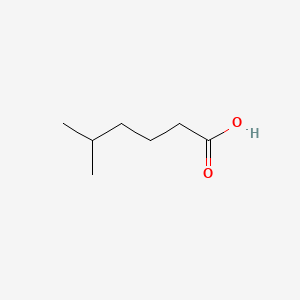| MeSH term | MeSH ID | Detail |
|---|---|---|
| Olfaction Disorders | D000857 | 17 associated lipids |
5-METHYLHEXANOIC ACID
5-METHYLHEXANOIC ACID is a lipid of Fatty Acyls (FA) class. 5-methylhexanoic acid is associated with abnormalities such as Little's Disease. The involved functions are known as inhibitors, Synthesis, Recurrence and Translation, Genetic.
Cross Reference
Introduction
To understand associated biological information of 5-METHYLHEXANOIC ACID, we collected biological information of abnormalities, associated pathways, cellular/molecular locations, biological functions, related genes/proteins, lipids and common seen animal/experimental models with organized paragraphs from literatures.
What diseases are associated with 5-METHYLHEXANOIC ACID?
5-METHYLHEXANOIC ACID is suspected in Little's Disease and other diseases in descending order of the highest number of associated sentences.
Related references are mostly published in these journals:
| Disease | Cross reference | Weighted score | Related literature |
|---|
Possible diseases from mapped MeSH terms on references
We collected disease MeSH terms mapped to the references associated with 5-METHYLHEXANOIC ACID
PubChem Associated disorders and diseases
What pathways are associated with 5-METHYLHEXANOIC ACID
There are no associated biomedical information in the current reference collection.
PubChem Biomolecular Interactions and Pathways
Link to PubChem Biomolecular Interactions and PathwaysWhat cellular locations are associated with 5-METHYLHEXANOIC ACID?
There are no associated biomedical information in the current reference collection.
What functions are associated with 5-METHYLHEXANOIC ACID?
Related references are published most in these journals:
| Function | Cross reference | Weighted score | Related literatures |
|---|
What lipids are associated with 5-METHYLHEXANOIC ACID?
There are no associated biomedical information in the current reference collection.
What genes are associated with 5-METHYLHEXANOIC ACID?
There are no associated biomedical information in the current reference collection.
What common seen animal models are associated with 5-METHYLHEXANOIC ACID?
There are no associated biomedical information in the current reference collection.
NCBI Entrez Crosslinks
All references with 5-METHYLHEXANOIC ACID
Download all related citations| Authors | Title | Published | Journal | PubMed Link |
|---|---|---|---|---|
| Li G et al. | Discovery, Synthesis, and Functional Characterization of a Novel Neuroprotective Natural Product from the Fruit of Alpinia oxyphylla for use in Parkinson's Disease Through LC/MS-Based Multivariate Data Analysis-Guided Fractionation. | 2016 | J. Proteome Res. | pmid:27246451 |
| Li XJ et al. | Thermophilic esterase from Thermomyces lanuginosus: molecular cloning, functional expression and biochemical characterization. | 2014 | Protein Expr. Purif. | pmid:24859676 |
| Ozyilmaz G and Yağız E | Isoamylacetate production by entrapped and covalently bound Candida rugosa and porcine pancreatic lipases. | 2012 | Food Chem | pmid:22980809 |
| Tabata J et al. | A new class of mealybug pheromones: a hemiterpene ester in the sex pheromone of Crisicoccus matsumotoi. | 2012 | Naturwissenschaften | pmid:22751867 |
| Curtin CD et al. | De-novo assembly and analysis of the heterozygous triploid genome of the wine spoilage yeast Dekkera bruxellensis AWRI1499. | 2012 | PLoS ONE | pmid:22470482 |
| Hahn MW et al. | The passive yet successful way of planktonic life: genomic and experimental analysis of the ecology of a free-living polynucleobacter population. | 2012 | PLoS ONE | pmid:22448227 |
| Chang P et al. | The antiepileptic drug valproic acid and other medium-chain fatty acids acutely reduce phosphoinositide levels independently of inositol in Dictyostelium. | 2012 | Dis Model Mech | pmid:21876211 |
| Grant BJ et al. | Electrostatically biased binding of kinesin to microtubules. | 2011 | PLoS Biol. | pmid:22140358 |
| Lei XH et al. | NASA-approved rotary bioreactor enhances proliferation of human epidermal stem cells and supports formation of 3D epidermis-like structure. | 2011 | PLoS ONE | pmid:22096490 |
| Anfora G et al. | Lateralization in the invertebrate brain: left-right asymmetry of olfaction in bumble bee, Bombus terrestris. | 2011 | PLoS ONE | pmid:21556150 |
